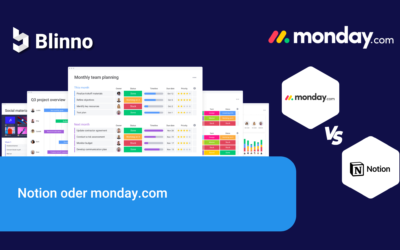Doing things manually is tedious. As your team grows and you take on more work, manual processes start to eat up your time and reduce your efficiency. They also entail risks that could cost your company dearly.
This is where workflow automation comes into play.
Simply put:
With workflow automation, you can reduce the time you spend on manual work. This leads to a faster and more productive team.
In this article, you’ll learn what workflow automation is, why it’s important for your business and how you can get started quickly with one of the best workflow automation platforms on the market.
What is workflow automation?
To understand what workflow automation is, let’s first define what a workflow is.
A workflow is a series of steps that you take to get something done.
Workflow automation therefore basically means the tools and processes that automate the flow of your work through these steps.
Implementing workflow automation means outlining your existing processes, finding your weak points and then introducing technology – like monday.com, which allows you to get rid of the boring, manual aspects of work – the aspects where you end up making mistakes because you fall asleep at your desk.
In short:
By automating your manual workflow, you can transform paper-intensive, people-based processes into elegant digital processes that drive your business forward.
This blog post is useful for a better understanding. Here we explain what monday.com workflow management actually is.
7 key benefits of workflow automation for your company
The introduction of workflow automation in your company can bring seven key benefits:
1. Increase in efficiency
By automating processes such as invoicing and payments, many of the usual delays can be eliminated, which not only shortens the time it takes to process invoices, but can also reduce the associated costs by over 67%.
Automated workflows also improve your ability to scale by allowing you to handle a greater number of tasks while ensuring consistent quality.
A good approach to start automating your workflows is to use templates for new processes instead of starting from scratch with every new project.
For example, instead of creating a new set of documents each time you plan a client’s digital marketing strategy, you could use a ready-made digital marketing plan template from monday.com to speed up the process.

2. Accuracy
Automation significantly reduces the chance of human error in your processes.
According to the 1-10-100 rule, it only costs 1 US dollar to check data on receipt, but 10 US dollars to correct errors in the next stage, and a full 100 US dollars to rectify errors.
Automated processes from the outset help to avoid high costs later on and facilitate compliance with new regulations by making it easy to update workflow forms and processes.
3. Cooperation
Automated workflows facilitate team collaboration. Automatic notifications of completed tasks and assignments mean:
-
- Those responsible can turn their attention to new tasks.
- You can start your task immediately.
This simplifies collaboration. When using platforms such as monday.com, this is particularly efficient thanks to notification triggers.

4. Speed
Thanks to real-time tracking and updates of tasks, your team can work more efficiently and complete more projects.
One example would be vacation requests: A manual workflow of the approval process could look something like this:
-
- The HR manager creates a vacation request form in Word.
- The HR manager prints out the form.
- The HR manager hands it to the employee requesting the leave.
- The employee fills out the form and signs it.
- The employee sends it to his supervisor for approval.
- The manager adds his signature to the form.
- The line manager submits the form to the HR manager.
- The HR manager adds his signature and completes the process.
- The HR manager files the form in his records.
This is a long, manual process with a lot of potential for delays and errors. What happens if your manager loses the form or the employee forgets to send it?
Here is an example of how the same process works with automation:
-
- An employee digitally fills out a vacation request template from the company’s cloud drive.
- The employee signs the form digitally and sends it off. It is then automatically sent to his superior.
- The manager signs the form digitally. It is automatically sent to the personnel manager.
- The HR manager adds his signature and completes the process. The form is automatically saved in the cloud. The employee is notified.
Automating the approval process makes work easier and faster for everyone. The time saved can then be used for other, more productive tasks.
5. Visualization
Visualize your workflow effortlessly with the right workflow automation software. A clear presentation of your work processes shows you exactly where you stand and what you need to do next.
With platforms like monday.com, you can immediately see who is waiting for your contribution and keep an eye on the progress of all tasks that are relevant to you.
Such automation platforms also allow team members to set filters to see only their own tasks and deadlines, making it easier to focus.

6. Productivity
More efficient workflows significantly increase your and your team’s productivity. Workflow automation minimizes the steps you need to take to achieve your goals.
An added benefit: many workflow automation platforms, such as monday.com, offer mobile apps that allow you to stay productive on the go.

7. Simple onboarding
The departure of an important team member can lead to interruptions. The internal notes, tasks and resources of the departing member are not always accessible to the team.
Workflow automation platforms provide a solution, with a central location for knowledge and shared documents that everyone can access. This simplifies the transition process enormously, regardless of whether someone is leaving or joining the team, and supports seamless onboarding.
Can workflow automation be successful for remote teams?
Workflow automation proves to be a great advantage for remote teams.
With the global increase in remote working in recent years, up to 60 % of companies have made a partial or complete switch to remote access. This way of working brings its own challenges. Without close proximity to colleagues who can provide answers quickly, searching for the right documents, tracking important events and updating tasks in real time can become frustrating.
As a manager, you may know the feeling of spending more time coordinating workflows than actually doing the work, while at the same time making sure the whole team stays informed about essential tasks.
Workflow automation makes remote work much easier, regardless of your team’s location. Team members receive automatic notifications when it’s their turn to complete a task, and once completed, the task is seamlessly passed on to the next person.
You no longer have to worry about who to make responsible for what or what your next task is. In addition, templates, documents, notes and status updates can be centralized so that the entire team is always up to date.
First steps in workflow automation
If you know the benefits of workflow automation, you may want to know how to apply this knowledge to your situation.
Here are six steps to help you get started with workflow automation.
1. Choose the right workflow automation platform
The right platform allows you to manage your workflow centrally and can greatly simplify work, increase productivity and improve team performance. A platform like monday.com could be an example here, offering industry-leading automation functions.

2. Identify processes that can be improved
The next step is to identify processes that can be optimized, which are often slow, manual processes that slow down your progress.
3. Plan the current processes
Once you have identified the processes to be improved, you should plan them to determine which ones should be automated. Questions such as “What needs to be done?”, “Who is responsible?”, “When does it need to be done?” and “How will it be done?” will help you to create a clear plan.
If you can answer these four questions in detail, you’re off to a good start. What you should not neglect, however, is the difficulty of the processes you want to automate. Some processes – such as employee onboarding – can be a little more complex than others (such as data entry or invoice submission).
When automating your workflows for the first time, try to start with less complicated processes and increase them over time.
For example, use our team task management template to assign one or more team members to each task so that everyone knows who is responsible for what.

4. Define goals for each process
For each identified process, the next step is to define the goal you want to achieve through automation, be it more speed, accuracy or efficiency. Then set clear KPIs to measure the results.
5. Carry out a gap analysis
Examine how the process is currently running, how it should ideally be running and how you can close the gap. This helps to identify areas for improvement.
6. Implement, evaluate and adapt
After selecting the right platform and identifying the process gaps, it is time to implement the new automated workflow. Test the new workflow step by step to identify and adjust problems. It is also important to obtain feedback and ensure that everyone in the team knows what is expected of them.
These steps will help you select the right automation solution and optimize your workflow effectively.

8 reasons why monday.com is ideal for workflow automation
An effective workflow automation platform should offer certain features to optimize the work for you and your team. While many solutions offer some of these functions, monday.com combines them all.
1. User friendliness
If a product is to make the workflow easier, the platform itself must be easy to use. It’s helpful to research the learning curve of any tool you’re considering.
monday.com offers live and on-demand webinars to help you learn how to use it as quickly as possible. You can also learn how to use the platform in five different languages (English, French, Spanish, German and Portuguese). This selection makes the tool accessible to almost everyone.
2. Cooperation
Efficient communication channels and the ability to share files and collect feedback are essential. monday.com allows you and your team to work together seamlessly, no matter where you are. Communication with customers is also guaranteed in this tool.
monday.com works hard to help you get your projects up to date and completed on time.
3. Mobile application
Access from anywhere is a must. monday.com offers apps for iOS and Android so that you can work flexibly while on the move.

4. Integration
The platform should be able to be integrated into other tools. With over 40 integrations, monday.com enables a seamless workflow with other software solutions.

5. Personalized presentations
Every company has individual processes that require a flexible design of the working views. monday.com offers lists, timelines, Kanban boards, Gantt charts and more for a personalized presentation of your data.
6. Analysis and reporting
In order to improve processes, they must be traceable and analyzable. monday.com offers comprehensive analysis tools for effective monitoring and optimization of your workflows.
This is what it looks like on a dashboard:

7. Flexible pricing
The costs should be adapted to the size of your team. monday.com offers flexible pricing plans that adapt to the needs of your business.
Find out more in our blog post about the prices
8. Live-Support
Knowing that support is quickly available if needed is reassuring. monday.com offers personalized support around the clock to make sure you get the help you need.
monday.com equips you with the tools you need to get started quickly and effectively, whether you work alone or in a team. Boost your productivity to a new level.
Conclusion
In summary, workflow automation with monday.com is an effective solution for reducing manual processes, increasing efficiency and improving team collaboration. Whether in the office environment or working from home, monday.com offers the flexibility, customizability and ease of use that modern businesses need to stay agile and productive.
As an official partner of monday.com, we will be happy to discuss your specific needs and show you how you can use monday.com to optimize your workflow automation. Whether you’re just starting out with automation or looking to optimize your existing processes, we offer the expertise and support you need to get the most out of this powerful platform.
Do you have any questions or need help with the setup? Do not hesitate to contact us. We’re here to help you take your productivity to the next level and successfully digitize your business with monday.com.







